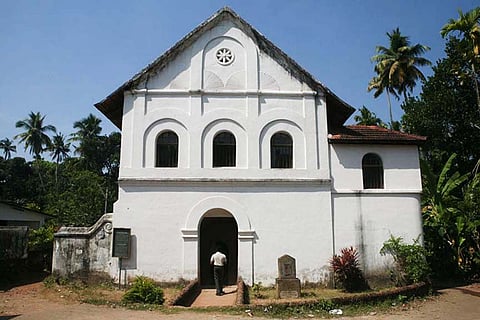
- Destinations
- Experiences
- Stay
- What's new
- Celebrating People
- Responsible Tourism
- CampaignsCampaigns
- Subscribe
- Buy Now

Walking through the Kottapuram market, one might think you've been transported to Mattanchery, albeit a few decades ago. The structures with stained glass, low set stairs and brightly painted entryways make you wonder what it would’ve been like to trade among the first few who arrived at the Muziris port. Situated close to the town of Chendamangalam, the market is one of the reasons why you should stop by Chendamangalam while visiting Kerala. Especially if you are a history buff. A casual lunch with Rasmi Poduval, founder of Cranganor History Cafe and Riverside Chateau, a resort, brought me back to the place for a two-day trip.
The history buff in me was blissfully satiated. “The market’s history can be traced back to the 1790s, during the reign of Shakthan Thamburan, of the erstwhile princely state of Cochin,” says Justin Joseph, manager of the resort, who accompanied us to the market. A canal connects the market to the Arabian Sea. The market is where early Arab immigrants, the Portuguese, and the Dutch came into trade over time. And nothing was off limits. Everything from black gold or pepper to peacocks and ducks to coffee and more would be bought and sold here.
There is little clarity on the time till when this town was a bustling port, but a significant turning point occurred in 1341 AD when the Periyar River flooded. This flood led to the siltation of the Muziris port and the subsequent establishment of a new port in Cochin.
After the market, I headed to Cheraman Palli and then Kottapuram Fort. The palli (mosque in Malayalam) was built in 629 AD by Malik Dinar, one of the first Muslims to arrive in India; it is said to be the first mosque built in the Indian sub-continent. The mosque was destroyed in 1504 by the Portuguese when the would-be third Governor of Portuguese India, Lopo Soares de Albergaria, attacked the port. It was then restored between mid-16th to early 17th century. The fort, too, has interesting stories to tell. It served as a burial ground for the Portuguese, says Lalji, the guide, who was present at remnants of the once handsome fort. She also pointed us to the preserved remains of a youth in his early 20s, who had been found at the site.
We then headed toward the Chendamangalam Synagogue, built in 1420 AD, making it the oldest synagogue in the Commonwealth of Nations. Near the synagogue entrance is a tombstone recovered from Kodungallur of ‘Sarah, daughter of Israel’, the oldest Jewish epitaph in India, dating back to 1269. The synagogue was patronised by local Jews, or as they were called ‘Black Jews’ at the time, due to their dark skin.
The hillock of Kottayil Kovilakam is also home to a Syrian Christian church, a mosque and a temple, all within a distance of 1km. This piece of history is verifiable proof that Kerala as a state is tolerant of all religions, and co-existence is at the core of its communities. Kodungallur, the town that assimilated many faiths, cultures and people from various parts of the world, could probably be called India’s first melting pot.
Chendamangalam is renowned for being home to the resilient Chendamangalam weaving community and the illustrious Paliam family. The male heads of this family, who were part of the Nair community, served as ministers to the rulers of the princely state of Cochin. Visiting the Paliam Palace, the residence of these ministers, offers an opportunity to explore their fascinating history. The palace features a torture chamber and a traditional Kerala-style home known as the Paliam naalu kettu, which includes a central courtyard. The images, relics, and artefacts within the palace tell stories of power, deceit, and torture, as the Paliath Achans (the title given to the male heads of the family) often acted as kingmakers.
Other places to visit in Chendamangalam include the Keezhthali Mahadeva Temple and the Paliam Puthiyathrikkovu Siva Temple. The courtyard of the latter features a shopping complex that appears to be frozen in time, comprising nine units. This structure is approximately 300 years old and offers items made from various crafts, such as pottery, handloom textiles, and temple art. Many of these monuments and historical buildings have been, and still are, somewhat overlooked by the average tourist.
After about two days of walking through historical buildings and monuments and immersing myself in stories of colonisers and ministers, I felt the need for an Ayurvedic massage to relax my mind and body. The Cranganor History Cafe and Riverside Chateau features a peaceful spa. An abhyangam, which involves gentle strokes, was exactly what my sore feet and back needed!
Chendamangalam is approximately 22 km from Cochin International Airport and about 26 km from Ernakulam town.
